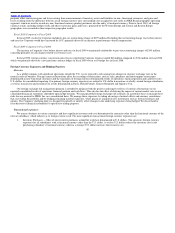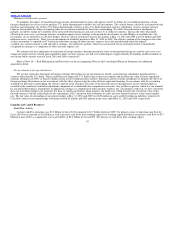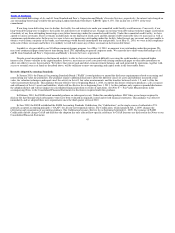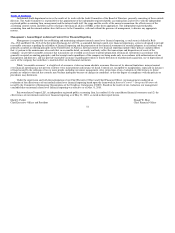Nike 2010 Annual Report Download - page 53
Download and view the complete annual report
Please find page 53 of the 2010 Nike annual report below. You can navigate through the pages in the report by either clicking on the pages listed below, or by using the keyword search tool below to find specific information within the annual report.
Table of Contents
net income some time after the maturity of the derivative. One of the criteria for this accounting treatment is that the forward and option contracts amount
should not be in excess of specifically identified anticipated transactions. By their very nature, our estimates of anticipated transactions may fluctuate over
time and may ultimately vary from actual transactions. When anticipated transaction estimates or actual transaction amounts decline below hedged levels, or
when it is not probable that a forecasted transaction will occur by the end of the originally specified time period or within an additional two−month period
of time thereafter, we are required to reclassify the ineffective portion of the cumulative changes in fair values of the related hedge contracts from other
comprehensive income to other (income) expense, net during the quarter in which such changes occur. Once an anticipated transaction estimate or actual
transaction amount decreases below hedged levels, we make adjustments to the related hedge contract in order to reduce the amount of the hedge contract to
that of the revised anticipated transaction.
We use forward contracts to hedge our investment in the net assets of certain international subsidiaries to offset foreign currency translation related to
our net investment in those subsidiaries. When appropriately designated as a hedge, the change in fair value of the forward contracts hedging our net
investments is reported in the cumulative translation adjustment component of accumulated other comprehensive income within stockholders’ equity to
offset the foreign currency translation adjustments on those investments. As the value of our underlying net investments in wholly−owned international
subsidiaries is known at the time a hedge is placed, the designated hedge is matched to the portion of our net investment at risk. Accordingly, the variability
involved in net investment hedges is substantially less than that of other types of hedge transactions and we do not expect any material ineffectiveness. We
consider, on a quarterly basis, the need to redesignate existing hedge relationships based on changes in the underlying net investment. Should the level of
our net investment decrease below hedged levels, any resulting ineffectiveness would be reported directly to earnings in the period incurred.
Stock−based Compensation
We account for stock−based compensation by estimating the fair value of stock−based compensation on the date of grant using the Black−Scholes
option pricing model. The Black−Scholes option pricing model requires the input of highly subjective assumptions including volatility. Expected volatility
is estimated based on implied volatility in market traded options on our common stock with a term greater than one year, along with other factors. Our
decision to use implied volatility was based on the availability of actively traded options on our common stock and our assessment that implied volatility is
more representative of future stock price trends than historical volatility. If factors change and we use different assumptions for estimating stock−based
compensation expense in future periods, stock−based compensation expense may differ materially in the future from that recorded in the current period.
Taxes
We record valuation allowances against our deferred tax assets, when necessary. Realization of deferred tax assets (such as net operating loss
carry−forwards) is dependent on future taxable earnings and is therefore uncertain. At least quarterly, we assess the likelihood that our deferred tax asset
balance will be recovered from future taxable income. To the extent we believe that recovery is not likely, we establish a valuation allowance against our
deferred tax asset, which increases our income tax expense in the period when such determination is made.
In addition, we have not recorded U.S. income tax expense for foreign earnings that we have determined to be indefinitely reinvested offshore, thus
reducing our overall income tax expense. The amount of earnings designated as indefinitely reinvested offshore is based upon the actual deployment of such
earnings in our offshore assets and our expectations of the future cash needs of our U.S. and foreign entities. Income tax considerations are also a factor in
determining the amount of foreign earnings to be indefinitely reinvested offshore.
50
























